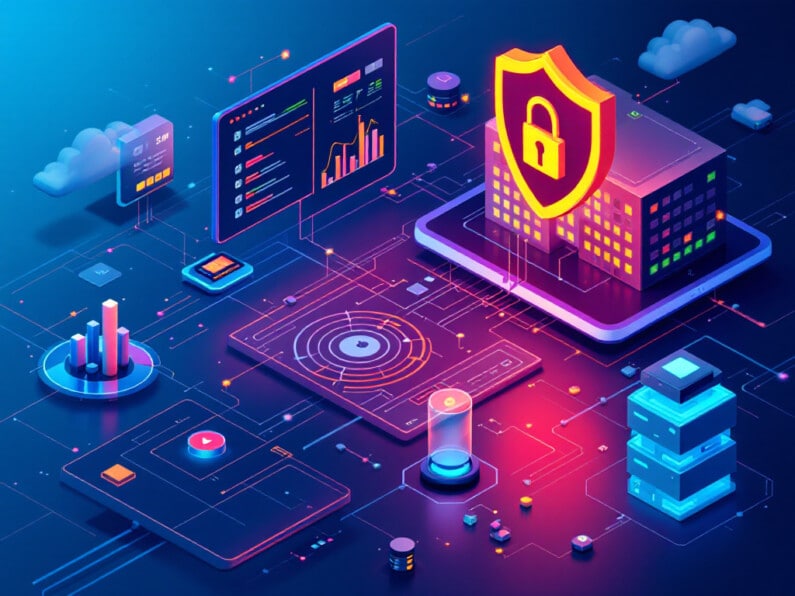A SIEM (Security Information and Event Management), is a cybersecurity software solution who acts as the brains behind an organisation's security.
It collects, standardises and analyses safety data from a variety of sources (event logs, security alertsnetwork data flows, etc.). to detect threats and security incidents in real time.

Illustration SIEM ©ORSYS/Alexandre SALQUE
🎯 SIEM objectives
- Threat detection : identify suspicious behaviour (attacks, intrusions, anomalies) using correlation rules, machine learning algorithms and artificial intelligence.
- Event correlation : link isolated, seemingly unrelated events to identify complex and sophisticated attack patterns.
- Regulatory compliance : generate customisable reports to meet the requirements of standards such as RGPD, ISO 27001PCI-DSS, HIPAA, etc.
- Incident response : provide real-time alerts to enable security teams to respond quickly and effectively to incidents.
- Analysis forensics : trace post-incident activities by exploiting historical logs to understand the extent of the attack, identify the vulnerabilities and improve safety.
👉 Types of SIEM
- On-Premises : deployed locally on the organisation's premises (e.g. IBM QRadar, Splunk). Offers total control, but requires significant maintenance.
- Cloud (SaaS) : Hosted and managed by a cloud service provider (e.g. Microsoft Sentinel, Sumo Logic). More flexible and scalable, but can raise security and compliance issues.
- Hybrid : combines cloud and local infrastructure. Allows you to benefit from the advantages of both models.
- Open source : customisable solutions (e.g. Elastic SIEM, Wazuh). Require in-house technical expertise.
- Managed SIEM : outsourced to an MSSP (Managed Security Service Provider). Ideal for companies with limited resources.
How it works
- Collection : retrieves logs and events from all sources (firewallIDS/IPS, servers, applications, etc.).
- Standardisation : structures data in a common format to facilitate analysis and correlation.
- Analysis: applies rules, machine learning or AI to detect threats and anomalies.
- Correlation : identifies the links between events to reconstruct the sequence of attacks.
- Alert and response : notifies security teams and triggers automated actions (e.g. IP blocking, system isolation).
- Reporting : generates dashboards and reports for compliance, audit and trend analysis.
✔ Benefits
- Centralisation : unified view of security threats and events.
- Proactive detection : reduction in response time (MTTD/MTTR) and minimisation of the impact of attacks.
- Compliance : automation of regulatory reporting and simplification of audits.
- Automation : integration with a SOAR (Security Orchestration, Automation, and Response) to automate incident response.
- Scalability : suitable for large infrastructures and high data volumes
✖ Disadvantages
- Complexity : demanding configuration and maintenance, requiring safety expertise.
- High costs : licences, log storage, expertise required, especially for on-premises solutions.
- False positives : irrelevant alerts if the rules are poorly configured, which can overwhelm security teams.
- Latency : processing times for very large volumes of data, which can have an impact on real-time detection.
- Log dependency : requires full instrumentation of systems for optimum visibility.
💰 Costs
- Licences : from a few thousand to hundreds of thousands of euros a year, depending on the size of the company and the features involved.
- Infrastructure : dedicated servers, storage, bandwidth (cost varies according to volume of logs and type of deployment).
- Maintenance : in-house or outsourced teams (MSSP).
- Training: team certification (e.g. Splunk, ArcSight).
📈 Trends 2025
- IA/ML : improved threat detection zero-day and abnormal behaviour thanks to machine learning and artificial intelligence.
- SOAR-SIEM convergence : Increased automation of incident response thanks to close integration between SIEM and SOAR solutions.
- Cloud-based SIEM : massive adoption of SaaS solutions for greater flexibility, scalability and cost reduction.
- Zero Trust : integration with Zero Trust architectures to strengthen access and data security.
- XDR (Extended Detection and Response) : merging SIEM capabilities with solutions EDR (Endpoint Detection and Response) for comprehensive protection against threats.
Examples of SIEM solutions
- Splunk Enterprise Security
- Microsoft Sentinel
- IBM QRadar
- LogRhythm
- Elastic SIEM
- Fortinet FortiSIEM
- Rapid7 InsightIDR
- Exabeam
📊 Key figures (2023-2024)
World :
- Global SIEM market : 6.4 billion in 2023, with a projection of $12.7 billion by 2028 (Source: Gartner).
- Adoption of the SIEM : 60 % of companies use a SIEM to respond to attacks from ransomware (Source: Gartner).
- Violation detection time : 207 days in average without SIEMagainst less than 50 days with a SIEM.
France :
- 70 % of large French companies have deployed a SIEM (Source: ANSSI).
- 45 % of SMEs use cloud-SIEM solutions (CESIN 2023 study).
- Average cost of a data breach : 4.2 million (up 15% since 2022).


